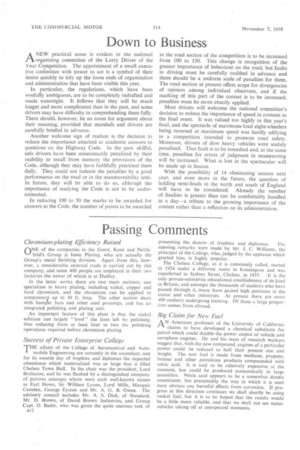Down to Business
Page 46

If you've noticed an error in this article please click here to report it so we can fix it.
ANEW practical sense is evident in the national organizing committee of the Lorry Driver of the Year Competition. The appointment of a small executive conimittee with power to act is a symbol of their desire quickly to tidy up the loose ends of organization and administration that have been visible this year.
In particular, the regulations, which have been woefully ambiguous, are to be completely redrafted and made watertight. It follows that they will be much longer and more complicated than in the past, and some drivers may have difficulty in comprehending them fully. There should, however, be no room for argument about their meaning, provided that marshals and drivers are carefully briefed in advance.
Another welcome sign of realism is the decision to reduce the importance attached to academic answers to questions on the Highway Code. In the past, skilful, safe drivers have been unnecessarily penalized by their inability to recall from memory the provisions of the Code, although they may have faithfully practised them daily. They could not redeem the penalties by a good performance on the road or in the manceuvrability tests. In future, they will be able to do so, although the importance of studying the Code is not to be underestimated.
In reducing 100 to 50 the marks to be awarded for answers to the Code, the number of points to be awarded in the road section of the competition is to be increased from 100 to 150. This change is recognition of the greater importance of behaviour on the road, but faults in driving must be carefully codified in advance and there should be a uniform scale of penalties for them. The road section at present offers scope for divergencies of opinion among individual -observers, and if the marking Of this part of the contest is to be increased, penalties must be more exactly applied.
Most drivers will welcome the national committee's decision to reduce the importance of speed in contests in the final event. It was valued too highly in this year's final, and the spectacle of maximum-load eight-wheelers being reversed at maximum speed was hardly edifying in a competition intended to promote road safety. Moreover, drivers of slow heavy vehicles were unduly penalized. That fault is to be remedied and, at the same time, penalties for errors of judgment in manceuvring will be increased. What is lost in the spectacular will be made up in finesse.
With the possibility of 14 eliminating centres next year, and even more in the future, the question of holding semi-finals in the north and south of England will have to be considered. Already the number of finalists is greater than can be comfortably handled in a day—a tribute to the growing importance of the contest rather than a reflection on its administration.












































































































































